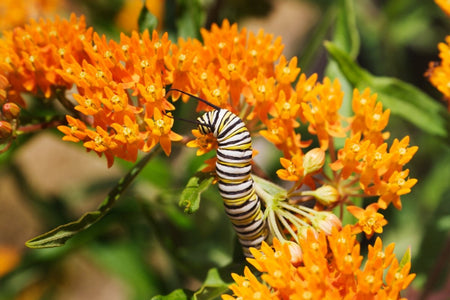Deer-Resistant Gardening with Native Plants

What to Do When Deer Are Damaging Your Garden?
In the heart of every wildlife enthusiast's garden lies a delicate balance between fostering biodiversity and safeguarding our cherished plants. At Garden for Wildlife, we advocate for a symbiosis that not only invites nature's splendor but also preserves the fruits of our labor.
Yet, an all-too-common guest, the deer, often finds our verdant sanctuaries irresistible. Today, we unravel the nitty-gritty to reveal a garden where your native plants thrive, flowers bloom, and deer roam without ravage.

Understanding deer palates
These graceful browsers, while often undiscriminating in their quests for food, do have a nuanced palate, particularly when it comes to their leafy feasts. But there are a lot of misconceptions about what deer will and won’t eat.
For example, despite popular belief, deer may occasionally graze on tomato plants, especially when their preferred food sources are scarce. Tomatoes aren’t the top choice for deer, but hunger can drive them to sample your savory crops. There are some quick and easy ways to ensure that your plants and any vegetables you grow don’t become a food source for local deer.
- Selective browsing: Deer tend to avoid certain plants due to their strong scents, textures, or flavors. This is where strategic planting can serve as a silent guard against these gentle marauders.
- Plants deer won't eat: Interspersing your garden design with native plant varieties that deer find less palatable can be a clever ruse. Consider surrounding your garden with the following:
Black eyed Susan: With its vibrant, daisy-like flowers, black eyed Susan is not only visually stunning but also tends to be off the menu for deer.
Anise hyssop: An aromatic herb with licorice-scented leaves, anise hyssop is often bypassed by deer in favor of less pungent greens.
Plants that repel deer: Some plants go beyond mere rejection; they actively repel deer. The blue flag iris is a great example of this, and its combination of beauty and deer resistance makes it a great choice. Its towering blooms serve as a flag of caution to wandering deer, signaling an area of less culinary appeal.
Deer deterrent strategies
Beyond planting, other garden design choices can help protect your garden from hungry deer. If you’re considering adding more design choices to your garden and you want to keep local deer populations at bay, bear the following in mind.
- Strategic planting: Plant deer-resistant varieties along the perimeter of your garden to create a natural barrier.
- Layered defenses: Combine plants with different sensory deterrents, such as those with prickly textures or strong scents, to create a multi-sensory deterrent.
- Deer-proofing with aesthetics in mind: In your mission to deter deer, remember the dual purpose of your garden: to protect your crops and to provide a sanctuary for wildlife. Choose plants like the great blue lobelia in our Pollinator Power set or the lanceleaf coreopsis from the Patio Party collection, which not only contributes to a deer-proof garden but also add splashes of color and texture, enhancing the biodiversity and beauty of your space.
Mastering how to keep deer away from a garden is an art of balance and understanding. By understanding the tastes and tendencies of our local deer, we can better design a garden that flourishes under our care while respecting the wildlife with which we share our outdoor spaces.
How to protect garden trees from deer
Majestic trees are often the backbone of any garden, providing structure, shade, and shelter. But when the local deer population sees these woody plants as a source of food, it's time to employ some tricks to shield them without disrupting the garden's harmony with wildlife.
Physical deterrents remain one of the most effective ways to protect trees from deer:
- Tree guards: Wrap trunks with specialized tree guards to prevent deer from rubbing against and damaging the bark.
- Mesh fencing: Encircle young trees with sturdy mesh fencing at least five feet tall to prevent deer from reaching the foliage.
Companion planting
By strategically pairing certain species, we can create a robust, layered defense that’s both effective and environmentally friendly. Here’s how to leverage the intrinsic properties of these plants to protect your garden's harmony without a single fence post.
- Height variation: Layer plants of varying heights to create a more complex barrier that deer are less likely to penetrate.
- Sensory confusion: Integrate plants with strong scents like anise hyssop to confuse and repel deer, reinforcing the protection around trees.
Companion planting example
While there are almost endless possibilities when it comes to companion planting, some options are particularly effective. Here’s a great example of combining plants that repel deer while also being incredibly beneficial for local pollinators:
- Sneezeweed: This robust perennial can serve as a deterrent with its height and texture, making it less appealing for deer to push past. Sneezeweed is particularly effective as a plant to deter deer.
- Purple lovegrass: The dense clumps of purple lovegrass can act as a physical barrier, and its texture may be off-putting to deer.
Tactical planting
In addition to using plants deer won't eat in your garden, strategically place them to create a buffer zone using the following tactics.

Routine Maintenance
Regularly inspect and maintain protective measures to ensure they remain effective:
- Check fences: Ensure fences and guards are intact and tall enough to keep deer out of a garden, as deer can be quite persistent.
- Prune lower branches: Raise the canopy by pruning lower branches to keep them out of reach from deer.
- Engaging community solutions: Collaborate with neighbors to implement area-wide deer management strategies, which can lessen the overall pressure on individual gardens and promote a healthier ecosystem balance.
Protecting your trees from deer is an ongoing process that benefits from a multifaceted approach. By employing these tactics, you're not just safeguarding your trees; you're also investing in the well-being of the local wildlife and the health of your entire garden ecosystem.
Are azaleas deer resistant?
Azaleas, with their brilliant blooms and lush foliage, are a staple in many gardens, but they also frequently raise the question of their vulnerability to deer. Let's unravel this question and explore how to safeguard these fantastic additions to your garden.
Azaleas may sometimes fall prey to deer, especially when other food sources are scarce. While not their first choice, hungry deer might still sample these plants. To protect your azaleas and keep deer out of a garden, a multi-tiered approach can be more effective than relying on a single solution.
- Initial barrier: Surround azaleas with plants deer won't eat, such as foxglove beardtongue, to form a living fence that's both beautiful and practical.
- Secondary protection: Integrate plants that repel deer, like grayleaf goldenrod, which can serve as a deterrent with its robust scent and less palatable foliage.
- Integrating deer-resistant plants: Enhance your garden's resilience by planting varieties known to be less appealing to deer. Some of these have already been mentioned, but another excellent companion, the smooth blue aster, has some incredibly dense growth that can help shield azaleas and add depth to your garden's design.
- Continuous blooms: Plan your garden so that flowers that repel deer are in bloom throughout the seasons, creating a consistent barrier that's as effective as it is enchanting. You can plan this well in advance by being aware of when to expect emergence from your native plants each year.
- Design with purpose: If you want to create a deer-proof garden, arrange deer-resistant plants in patterns that complement the azaleas, ensuring that practicality doesn't come at the expense of beauty.
- Color coordination: Choose plants like the great blue lobelia, which can harmonize with the azaleas' vibrant colors for a garden that's pleasing to the eye and less attractive to deer.
By adopting a thoughtful, layered planting strategy, you can enjoy the splendor of azaleas without surrendering them to the appetites of local deer. This method not only answers the question of whether azaleas are deer-resistant but also transforms the potential challenge into an opportunity for creative garden design.
Designing a deer-resistant wildlife garden
When it comes to cultivating a garden that’s both a haven for wildlife and a fortress against deer, strategic design is key. Begin with a strong foundation of plants that repel deer to create an environment where your flora can thrive without the threat of being a deer's dinner.
- Versatile variety: Incorporate a variety of plants from our collection, such as the stately oxeye sunflower, known for its deer-resistant qualities.
- Strategic arrangements: Position these plants around the perimeter of your garden as a first line of defense to deter deer and add aesthetic value with their bright blooms and varied textures.
Layering for effectiveness
Employ a layering technique in your garden's layout to create depth and complexity that deer find difficult to penetrate. Try the following:
- Height variation: We’ve already mentioned this, but it’s so effective that it’s worth mentioning twice. Arrange your plants in ascending order of height to create a staggered visual effect that naturally keeps deer away from the garden.
- Density deterrent: Dense plantings can act as a physical barrier, making it harder for deer to navigate and access more desirable plants.
- Wildlife-friendly features: Add elements like orange butterfly milkweed and zig-zag goldenrod, which offer both beauty and a habitat for wildlife.
- Visit our full collection: We invite you to explore our complete selection of deer-resistant plants. Each has been chosen not only for its resilience to deer but also for its contribution to a deer-proof garden that supports our local ecosystems.
By weaving together these elements, your garden can be a beautiful display of color, texture, and life, all while serving as a testament to your commitment to wildlife and your defense against deer.
The ethics of gardening with wildlife in mind

Our strategies for how to keep deer away from gardens transcend basic deterrents. Instead, it’s a pledge to deter deer with compassion and mindfulness. With each deer-proof garden we design, we uphold the symbiotic relationship between man and nature, ensuring our practices enrich rather than encroach upon the lives of our wild neighbors.
We sow plants deer won't eat and plants that repel deer not only to protect our labors but to preserve the natural order. The beauty of a garden should be measured not just by the blooms of the flowers that repel deer but by the ethical principles that bloom in tandem with them.
As we continue to share this journey, we extend an invitation to deepen your connection with us. Sign up for our email newsletter and immerse yourself in a community of like-minded individuals passionate about wildlife-friendly gardening. Gain insights into creating a harmonious garden, receive special offers, and be the first to know when new native plants, like the serene blue flag iris or the resilient prairie dropseed, become available for sale.

Find Native Plants by Zip Code
We took the guesswork out of planting native. Check your zip to see what ships!



















